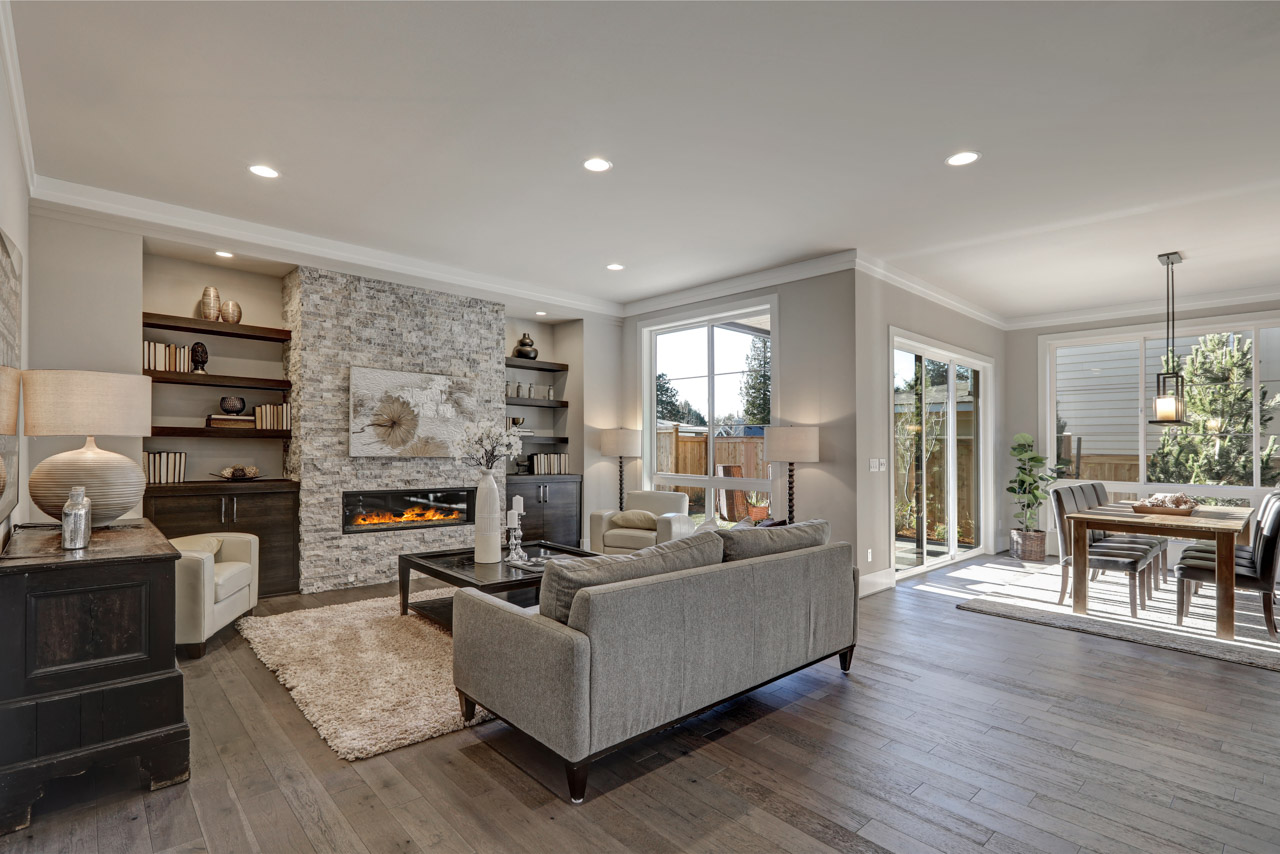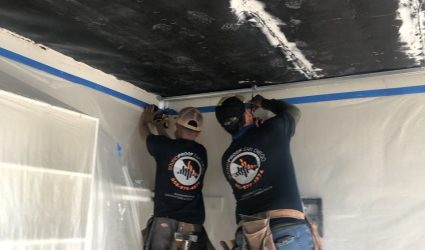How We Help Homeowners
Welcome to our website, and thank you for considering our soundproofing and acoustical services. We understand that living in a noisy environment can be frustrating and stressful. That’s why we are here to help you create a peaceful and comfortable living space for you and your family.
Noise pollution is not only disruptive to our peace of mind, but it can also lead to significant health issues.
Excessive noise can cause distraction, reduce productivity and concentration levels, and even hinder learning abilities.
Our team of experts is experienced in providing customized soundproofing solutions that can meet your specific needs and budget.
From sound-absorbing panels and insulated windows to acoustic doors and ceiling treatments, we have a range of options for you to choose from.
We use high-quality materials and advanced technology to deliver exceptional soundproofing and acoustic solutions that are efficient, durable, and cost-effective.
Our soundproofing services are available to all types of residential properties throughout Southern California.
We are committed to providing excellent customer service and strive to ensure that your experience with us is hassle-free and satisfactory.
Our team of professionals will guide you through every step of the process, from consultation to installation.
Investing in soundproofing or acoustical services is not just a luxury, it’s a necessity for a better quality of life.
Don’t let noise pollution disrupt your peace and well-being.
Contact us today to learn more about our services and how we can assist you in creating a quieter, calmer, and more comfortable living space.


Featured Applications
Reduce Unwanted Sounds
By minimizing sound transmission, Soundproof San Diego provides homeowners with increased comfort, privacy, and tranquility.
Are You Having Problems With Any of the Following:
- Loud Neighors, Kids, or Animals
- Footfall/Impact Noise
- Family Noise
- Loud TVs, Radio's, or Game Playing Noise
- Kitchen or Laundry Room Noise
- Trains, Planes, Automobiles
- Neighborhood Noise/Parties
- Venue Noise
- Pool Equipment/Mechanical Noises
- Loud HVAC Systems
- Pipe/Sewer/Water Noise
- Frequent Piano/Music/Singing Practice
- Echo Problems
Do You Live in Close Proximity to:
- Schools
- Live Venues
- Frequent Neighborhood Parties
- Frequent Alarms Going Off
Sound Proof San Diego Can Help!

These Are the Most Frequently Asked Questions We Receive About Soundproofing and Acoustical Treatments
We are happy to answer your questions over the phone as well, don’t hesitate to reach out!
Soundproofing is the process of reducing or blocking the transmission of sound from one space to another. It involves using materials and techniques to absorb, dampen, or isolate sound waves, thereby minimizing their impact on the receiving space.
Soundproofing focuses on preventing sound from entering or leaving a space, while acoustic treatment is about improving the sound quality within a room. Soundproofing deals with sound transmission, while acoustic treatment addresses sound reflections and reverberations.
Yes soundproofing can be done in existing rooms
Sound can be categorized into various types, including airborne sound (like voices and music) and impact sound (like footsteps). Sounds also have different frequencies, ranging from low-frequency bass to high-frequency treble.
Sound Transmission Class (STC) and Outdoor-Indoor Transmission Class (OITC) ratings are used to evaluate and specify the sound insulation or sound transmission properties of building materials, walls, windows, and other elements within buildings.
These ratings are important for various professionals and individuals involved in the construction and design of buildings, particularly those concerned with noise control and acoustic performance.
Here are some of the key users and contexts for STC and OITC ratings:
Architects and Building Designers: Architects and building designers use STC and OITC ratings to select materials and building assemblies that will provide the desired level of sound insulation in various building types, such as residential, commercial, and industrial buildings. They design spaces with the goal of meeting specific acoustic requirements and minimizing noise transmission between rooms and from outside sources.
Acoustic Consultants: Acoustic consultants (that's us!) are experts in designing spaces with optimal acoustic performance. We utilize STC and OITC ratings to assess and recommend building materials and construction techniques to achieve specific sound isolation goals in our projects.
Construction and Building Contractors: Contractors are responsible for implementing the designs and specifications provided by architects and designers. They need to understand and work with materials that have specific STC and OITC ratings to ensure that the intended level of sound isolation is achieved during the construction process.
Manufacturers and Suppliers: Manufacturers of building materials, windows, doors, and other sound-insulating products provide STC and OITC ratings for their products. These ratings help customers, including architects and builders, choose the right materials to meet their sound insulation needs.
Building Owners and Facility Managers: Building owners and managers are concerned with maintaining a comfortable and quiet indoor environment. They use STC and OITC ratings to assess and upgrade the sound insulation of their buildings as needed, especially in multi-unit residential buildings, hotels, and commercial properties.
Acoustic Engineers and Researchers: Acoustic engineers and researchers use STC and OITC ratings to study and improve the acoustic performance of building materials and assemblies. They may develop new sound-insulating materials and test their performance based on these ratings.
Regulatory Authorities and Building Codes: Some building codes and regulations specify minimum STC and OITC requirements for certain types of buildings, such as residential dwellings or healthcare facilities. Compliance with these standards is essential to ensure occupant comfort and safety.
STC and OITC ratings provide standardized methods for assessing the sound insulation properties of building elements, helping professionals and individuals make informed decisions to create spaces with the desired level of noise control and acoustic privacy.
For more information about STC and OITC Ratings, check out our blog post!
The term "NRC rating" refers to the Noise Reduction Coefficient, a measure of how well a material or surface can absorb sound and reduce its reflection. NRC ratings are used in the fields of architecture, interior design, and acoustics to assess and specify materials for the acoustic performance of a space.
Here are some of the primary users and contexts where NRC ratings are important:
Architects and Interior Designers: Architects and interior designers use NRC ratings to select materials such as wall panels, ceiling tiles, flooring, and furniture that can improve the acoustic environment within a building. They choose materials with specific NRC ratings to achieve the desired level of sound absorption and control in various spaces, such as offices, conference rooms, auditoriums, and residential homes.
Acoustic Consultants (That's us!) : Acoustic consultants are professionals who specialize in designing spaces with optimal acoustic properties. We use NRC ratings to recommend suitable materials and construction methods to meet specific sound control requirements. This is often for projects like theaters, recording studios, and concert halls.
Building Owners and Facility Managers: Building owners and facility managers are responsible for maintaining and improving the acoustic performance of their properties.
They use NRC ratings when renovating or retrofitting spaces to enhance their acoustic qualities, which can have a significant impact on occupant comfort and productivity.
Manufacturers and Suppliers: Manufacturers of acoustic products, such as acoustic panels, ceiling tiles, and flooring materials, provide NRC ratings for their products. These ratings help customers, including architects and designers, make informed decisions when selecting materials for their projects.
Acoustic Researchers and Engineers: Researchers and engineers in the field of acoustics use NRC ratings as part of their studies and experiments. They may also develop new materials and technologies to improve acoustic performance and test them against established standards, including NRC.
Regulatory Authorities: Some building codes and regulations may stipulate minimum NRC requirements for specific types of spaces to ensure occupant comfort and safety.
Consumers: Homeowners and individuals looking to improve the acoustics of their living spaces may also refer to NRC ratings when selecting acoustic products for personal use.
NRC ratings provide a standardized way to assess the sound-absorbing properties of materials, helping professionals and individuals make informed decisions when designing, constructing, or renovating spaces with specific acoustic requirements.
For more information about NRC Ratings, check out our blog post:
The Impact Insulation Class (IIC) rating is a measure of a floor assembly's ability to reduce the transmission of impact noise, such as footsteps or objects being dropped, from one level of a building to another. IIC ratings are particularly important for professionals and individuals involved in the construction, design, or renovation of buildings, where noise control between floors is a concern. Here are some key users and contexts where IIC ratings are relevant:
Architects and Building Designers: Architects and building designers use IIC ratings to select flooring materials and systems that can help achieve the desired level of noise control between different levels of a building. They may specify flooring solutions with high IIC ratings to reduce impact noise transmission in multi-story residential, commercial, or institutional buildings.
Acoustic Consultants: Acoustic consultants (That's us!) specializing in architectural acoustics use IIC ratings to evaluate and recommend floor assembly designs, materials, and construction techniques to achieve specific impact noise reduction goals in our projects. We work on a range of buildings, including residential, commercial, and industrial.
Construction and Building Contractors: Contractors are responsible for implementing the design and specifications provided by architects and designers. They need to understand and work with flooring materials and assemblies that meet or exceed certain IIC ratings to ensure effective impact noise control during construction.
Manufacturers and Suppliers: Manufacturers of flooring materials and systems provide IIC ratings for their products. These ratings help customers, including architects and builders, choose appropriate flooring solutions to meet their impact noise reduction needs.
Building Owners and Facility Managers: Building owners and managers are concerned with maintaining a comfortable and noise-free indoor environment. They use IIC ratings when selecting or upgrading flooring materials and systems to reduce impact noise transmission within their buildings, particularly in multi-unit residential buildings, hotels, and commercial properties.
Acoustic Engineers and Researchers: Acoustic engineers and researchers may use IIC ratings to study and improve the impact noise performance of flooring materials and systems. They may develop new products or construction methods and test them based on these ratings.
Regulatory Authorities and Building Codes: Some building codes and regulations may stipulate minimum IIC requirements for specific types of buildings to ensure that noise transmission between floors meets certain standards.
IIC ratings play a crucial role in ensuring that buildings provide effective impact noise control, which is essential for occupant comfort and acoustic privacy in multi-story structures. Professionals and individuals involved in the construction and design of buildings rely on IIC ratings to make informed decisions about flooring materials and systems.
For more information about IIC Ratings, check out our blog post!
Testimonials
Clients who hire Soundproof San Diego desire to work with someone who is knowledgeable and provides peace of mind, most of our clients are literally at their witts end by the time they reach out to us, and we are honored to serve them, restoring order and sanity back to their lives.
Soundproof San Diego is one of the best contractors I have worked with. Neil is one of the most detailed people I have ever met and helped me decide what worked best with the rooms I needed soundproof. The team worked their butts off on a tight timeline and my god the end result was amazing. I highly recommend Soundproof San Diego to anyone, even simple jobs! You will not be disappointed.
Soundproof San Diego is one of the highest quality contractors I have ever worked with (and I grew up in a contractor family). From Neil’s initial contact and evaluation, through work of the crew, very professional and excellent work. I had Bill as the project PM and he was very communicative and very easy to work with. We discovered one small issue the last day of the 4 week job, and the crew immediately addressed it, no questions asked. This work was done for the ceilings of 1/2 of a condo built in the 70s. The results are as expected, not “library silence”, but massive sound reduction from the AirBnB above me. I will have them back at some point to do the other half of my unit. you cannot go wrong with Soundproof San Diego.
We hired Soundproof San Diego to create more privacy between our house and an attached ADU. They were able to assess our situation and provide several different treatment options. After about a weeks worth of work, they successfully completed the project which included a complete teardown of the wall between the two units. The soundproof job is so great that you can't hear basically any noise between the units accomplishing exactly as we had wished for. The team was super communicative and helpful throughout this process.








